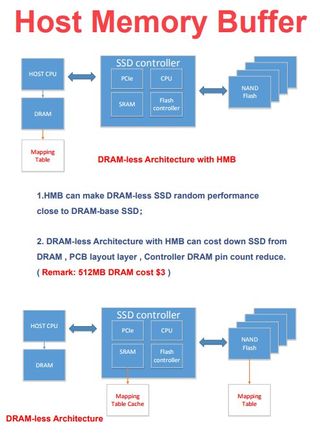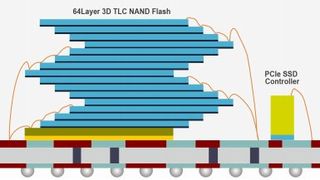Intel Outs Unannounced 1TB BGA SSD, 64L 512Gb NAND Die
SSDs are getting smaller every day, as evidenced by a new unnamed Intel SSD that the company let slip in a year-in-review document. Intel released the image of a new 1TB BGA SSD with little fanfare, but while we don't know many definitive technical details, we can deduce a few things from the design.
Intel will soon join Toshiba and Samsung with a multichip package (MCP) SSD sporting up to 1TB of 3D NAND capacity. A leaked roadmap earlier this year listed a BGA-mounted 1TB Intel 600p SSD, but we cannot verify that this is a 600p model.


The image doesn't specifically state the BGA package pictured on the far right is an SSD. It refers to the package as "what a terabyte of 3D NAND from Intel will look like next year." Here is the full text:
Left to right: A first-generation 1 terabyte Intel 3D NAND SSD (solid state drive) from 2016; a second-generation 1 terabyte 3D NAND drive from 2017; at right, what a terabyte of 3D NAND from Intel will look like next year.
The size of the package and the pin count suggest that this isn’t a simple NAND package. The new package is larger than the NAND on the Intel 600p SSD. The BGA "solder ball" layout also identifies the package as an MCP SSD.

Single-package SSDs fall under the PCI-SIG, and there are four standard form factors. The Toshiba and Samsung products use the Type 1620 package that measures 16mm by 20mm. The form factor can operate over a SATA 6Gb/s bus or PCIe 3.0 with either two or four lanes (presumably NVMe).
Stay on the Cutting Edge
Join the experts who read Tom's Hardware for the inside track on enthusiast PC tech news — and have for over 25 years. We'll send breaking news and in-depth reviews of CPUs, GPUs, AI, maker hardware and more straight to your inbox.

The single BGA package can be mounted to a standard M.2 PCB or a motherboard. A direct motherboard mount is often used in low-cost notebooks, like Chromebooks. The image above shows Toshiba's BG3 SSD that connects via a PCIe 3.0 x2 interface. It comes in capacities up to 512GB. The BG3 also introduced us to Host Memory Buffer (HMB) technology.
HMB allows SSD manufacturers to eliminate the expense of dedicated DRAM that normally houses the address table. That makes it a DRAM-less SSD, but without the severe random performance penalty. Instead, the NVMe device communicates directly with the system memory and uses a small portion of RAM to cache the table. The result is performance that closely matches an SSD with a dedicated DRAM cache.

It's unclear if Intel is using HMB technology with the BGA SSD, but it is a possibility. Intel doesn't have a DRAM fab, so it would make sense to remove the DRAM component if it can. It also reduces cost compared to Package-On-Package (PoP) designs. HMB support is now built into Windows 10 and Linux, so it doesn't require extra drivers or software.

The Intel document also hints at the timeline for IMFT's (Intel/Micron Flash Technologies) new 64-layer 512Gbit (64GB) NAND die. Intel can stack up to 16 NAND die per package, but that would only create a 512GB package with the existing 256Gb (32GB) die. Micron, Intel's NAND manufacturing partner, has already confirmed the existence of a larger die capacity coming in the 64-layer memory product family. Intel would need the larger 512Gbit die to reach 1TB in a single package using 16 die.

In this image from Longsys, another company with a multi-chip package SSD, we see how the technology is laid out inside a single BGA chip. Longsys works closely with IMFT and uses the 3D NAND for many of its products.
We've followed up with Intel for more information on the new device, but we await further details. We'll keep you updated as additional information comes to light, but we strongly suspect that will happen at CES 2018 in two weeks.
-
FD2Raptor "HMB support is now built into Windows 10 and Linux, so it doesn't require extra drivers or software."Reply
Does that mean that these SSD will require driver installation for use with W7/8? -
marc_douville https://www.adverts.ie/hard-drives/intel-ssd-540s-series-1tb-manufacturer-warranty/14481235Reply -
CRamseyer I don't know if Windows 7 or 8 will enable HMB support. It's one of the questions I plan to address at CES.Reply
Most Popular



